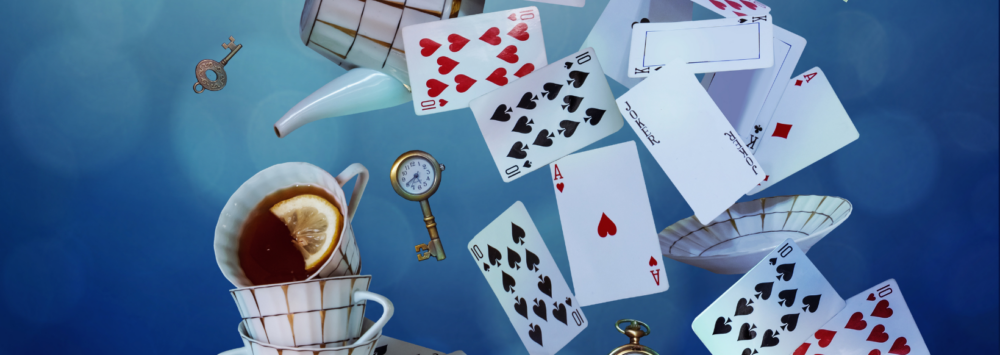By Krista Reed
OCD is often called an “intruder”, a “bully” and even a “worthy adversary.” In this case, I am going to compare it to one of my all-time favorite childhood stories, Alice in Wonderland. OCD is 100% Alice, the antagonist, whereas Wonderland is the protagonist.
Let’s talk about this tale from Wonderland's perspective. Wonderland is a thriving community, yes not a perfect one; however, thriving. It was ruled by a megalomaniac monarch who was so preoccupied with her roses that she failed to pay attention to the eccentrics of the land. Granted, if she had realized how odd the land truly was, she might have ended up with dead roses on account of her harsh death penalty laws. The residents had their hobbies, and their friends, and abided by society's silly and sometimes nonsensical rules.
Now one might argue, if Wonderland has silly rules and nonsensical expectations would that not be OCD instead? Absolutely not and for one very good reason. The rules and expectations of Wonderland, although inane and irrational to us, are ego-syntonic to the residents (not outside of their values and personalities.) Alice is the intruder; and here is how I believe she represents OCD.
First things first. Metaphorically speaking, OCD creates an endless rabbit hole. Alice begins the story by falling down a rabbit hole; uninvited, coincidence? Perhaps, however, let us continue. When Alice reaches the bottom, she realizes that she cannot fit into the door to get into the secret garden; therefore, she must manipulate her body to fit. With the simple commands provided, “drink me” and “eat me”, she eventually gets to be the size she needs before going through the door, not easily of course. Wonderland attempted to drown out Alice’s intrusive existence, literally, with her own tears.

Once Alice has entered the society of Wonderland, she meets a variety of characters along the way. Each character presents their oddities, attempts a barrier for Alice, and somehow Alice overcomes every single one. She unapologetically goes into the White Rabbit’s house and nearly destroys it due to drinking a bottle that caused her to grow; then becoming upset when the Rabbit discovered her ruining his home. The Hookah-Smoking Caterpillar, who appeared to be attempting to baffle Alice using a form of irritating Socratic questioning, eventually gave in to what Alice was wanting. The Mad Hatter and the March Hare initially told Alice that there would be no room for her at their table and yet, Alice insisted that they were wrong and invited herself in anyway and then was insulted when she was not treated with respect.
As is the case with OCD, it will make several attempts to “outwit” the individual. The more creative and intelligent the individual, the more creative and intelligent OCD must become. OCD cannot be “drowned out” by distractions, it will not be changed by the reactions of others, it cannot be defeated by questions that only dig deeper into nowhere, and it does not have to be invited to sit at anyone’s table. One thing that both OCD and Alice do is that they leave an impression anywhere they visit: not exactly a pleasant one. The residents of Wonderland are annoyed, frustrated, insulted, and angry with Alice’s choices; similar feelings that an individual experiences with OCD. No matter what the residents do, Alice continues her way, affecting more residents, and eventually upsetting the all-powerful ruler of the land, the Queen of Hearts.
Alice’s first run-in with the Queen of hearts, was immediately defiant. Alice was instructed to bow and not look the queen in the eye, which she naturally did anyway, and the Queen then threatened for Alice’s head to be removed as a result. Alice was lucky that the King was present as he saw the innocence in Alice and believed her to be naïve and young. That is a direct example of someone trying to rationalize and reassure OCD! “My obsession can’t be real, right? It’s harmless, right?” Well. OCD is a clever one and so is Alice. The Queen of Hearts, while cruel and impulsive, has more bark to her bite. Few characters are beheaded, and more are simply threatened. She may have caused some fear for Alice; however, Alice still overcomes and sees through the Queen’s sinister words.

My favorite character, the Cheshire Cat, might also be the reason that Wonderland wins. The Cheshire Cat is the only character that does not challenge or fight Alice. In fact, he teaches Alice about Wonderland and all the “madness.” I found his wisdom and disappearing acts to model Non-Engagement Responses. The Cheshire Cat acknowledges Alice’s presence and is neither annoyed or delighted, he remains neutral (perhaps an early reference to Acceptance and Commitment Therapy.) Wonderland’s residents were disturbed by Alice’s intrusion and her reluctance to adhere to their ways, the Cheshire Cat simply did not care. In fact, his explanation of how everyone is “mad” is essentially what allowed Alice to leave Wonderland and wake up.
I could dissect every single character within this whimsical story; however, I believe my point has been made. Alice, the intruder, who does not take Wonderland’s residents too seriously and attempts to control them with little care to their worldview, is eventually defeated and pushed out by the Queen’s army of cards. Alice tried her best to outsmart the residents, and at the end, they were able to force her to leave. They stood up to her and were not persuaded by her “politeness”, which was more condescending. OCD can truly appear to seem as if it is a wolf in sheep’s clothing; or to keep the theme, a Jabberwocky in a blue dress.
Next time you read any of the stories with Alice or watch any of the movies made with the same storyline, watch it from this view. Perhaps you will see things from the Cheshire Cat’s perspective, “I am not crazy. My reality is just different than yours.”


YES my whole life has been mad. I just turned 50 and this is just out of control.
BTW I AM NOT CRAZY , my reality is just different than yours !!!
Is it not a fantastic quote?!?
YES…So much so…I have saved this and read it so many times.